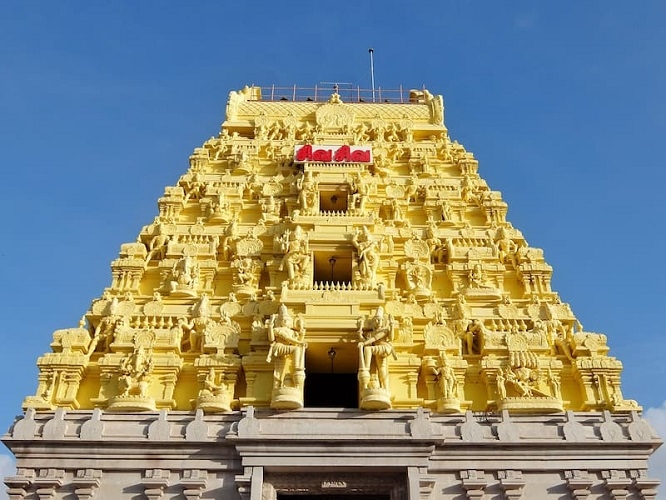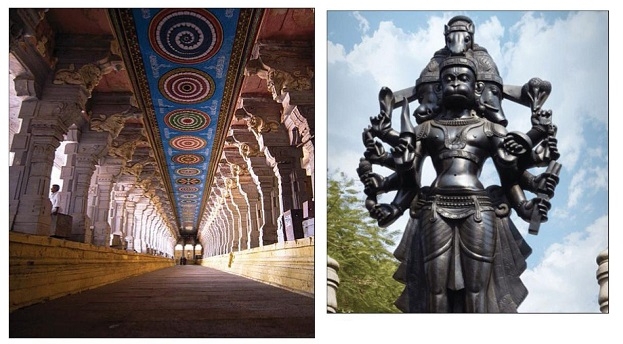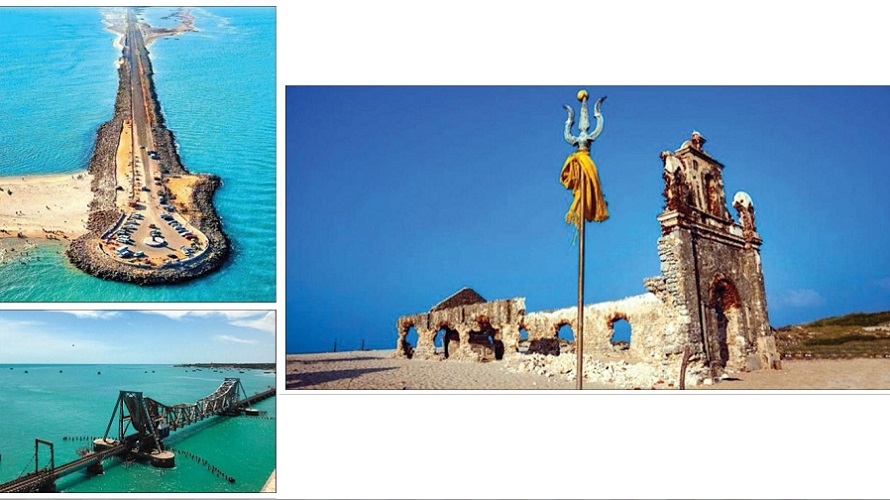Revered Rameswaram !
| Date :16-Jul-2023 |

By REKHA NARSIKAR :
Sometimes some locations, monuments or
shrines are so significant or unique, that
they become the identity of place to which
they belong to. Taj Mahal for Agra for
instance, Pangong Lake for Ladakh, Golden
Temple for Amritsar… so on and so forth.
Likewise, when I decided to visit Rameswaram,
Ramanathaswamy Temple was the solitary reason
the town was known to me!
The small vintage town clustered in the Pamban
Island in the southern state of Tamil Nadu is predominantly famous as a distinguished Hindu pilgrimage site – one of the Char Dhams as well as the
southernmost of the Twelve Jyotirlingas.
The majestic Ramanathaswamy Temple is an
embodiment of Dravidian Architecture. This temple
dedicated to Lord Shiva was built by King
Muthuramalinga Sethupathiy in the 12th century.
There are two Shivalingas inside the temple. The
sand Shivalingam is believed to be installed and
worshipped by Lord Rama to atone the sin of killing
Ravana, a Brahmin and great Shiva Disciple himself; whereas the Vishwalinga is the one brought by
Hanuman from Kailash Parbat. According to
another version, Lord Rama installed the Lingam
before proceeding to Sri Lanka.
The temple spreads over 15 acres and has tall
gopurams, a giant Nandi, elaborate corridors and
carved granite pillars.

The set of three corridors of
Ramanathaswamy Temple is considered to be the
longest set of temple corridors in the world. There
are 64 Tirthas or sacred water bodies in an around
Rameswaram out of which 22 are within the temple. The 22 Tirthas
represent 22
arrows in Lord
Rama’s quiver.
Devotees bathe in
these Tirthas to
wash off their sins
and discover divine
path. Agni Tirtham,
the one situated
behind the east
gate of the temple
facing the Bay of
Bengal is the most visited Tirthas of Rameswaram,
especially by child-less couples. The beautiful temple
and the spectacular settings attract not only devotees but tourists from all over the world.
At a distance of about 25 km from Rameswaram
is situated the small town of Dhanushkodi.
Dhanushkodi literally means end of bow. The place
gets its name from the Kodanda bow of Lord Rama.
It is said that Lord Rama, with the end of his bow,
marked this place for building a Setu or bridge to
enter Sri Lanka to save his wife Sita.

The ‘VanarSena’ or army of monkey-humans built the Setu
with floating stones bearing the name of Lord
Rama. Upon their return, Lord Rama handed over
the reigns of Sri Lanka to Vibhishana in
Dhanushkodi where now stands the
Kothandaramaswamy Temple.
Legend has it that Vibhishana expressed his fear
to Lord Rama that the Indian kings would use Ramsetu to attack Sri Lanka. Lord Rama, therefore, shot
an arrow and the setu was submerged a few feet
below water level. Some believe that this is the real
story behind the name Dhanushkodi. Interestingly,
navigation by sea-worthy vessels is impossible in
this stretch even in the present day due to superficial level of the sea along the setu! Dhanushkodi
was washed away during the 1964 cyclone, but the
Kothandaramaswamy temple remained intact!
Other important temples in Rameswaram include
Jada Tirtham, Panchmukhi Hanuman Temple,
Lakshmana Teertham, Gandhamadhana
Parvatham and Nambu Nayaki Amman Temple.
The sanctified temples, sacred Tirthas and the fascinating mythical stories woven around each of them
make Rameswaram as a prime Hindu spiritual terminus in India.
Rameswaram, however, offers much
more beyond its indisputable spiritual
connect!
First and foremost, its Geographical
connotations! Rameswaram is located
on Pamban Island which lies at the tip
of the Indian peninsula in the Gulf of
Mannar. Dhanushkodi, on the confluence of Bay of Bengal and Indian
Ocean is the southernmost tip of the
island. The distance between
Dhanushkodi in India and
Talaimannar in Sri Lanka is less than
30 km! From Dhanushkodi, one can
catch a glimpse of the mythological
Ram-setu. Geological evidence suggests that this was indeed a former
land connection between India and
Sri Lanka. Even today we can see a
chain of large stones arranged in one
line in the form of a bridge. The 50
km long bridge made with floating
stones separates the Gulf of Mannar
and Palk Strait. It is an incredible
form of architecture, the detailed
description of which is found in
Valmiki Ramayana. Scientists, geologists, scholars, engineers and architects across the world till date are
intrigued with the structure.
The buzz
created around the Ram-setu through
controversies, legal cases and latest
Bollywood movie with the same name
has triggered a great curiosity
amongst Indians. More and more
tourists are now eager to visit
Dhanushkodi and have a dekko at
Ram-setu!
Dhanushkodi is trulyamagical
place where we can see the blue
waters of the Indian Ocean on one
side and the brackish waters of the
Bay of Bengal on the other! Digging
up to 3 feet in Dhanushkodi is said to
exude sweet water -amarvel of
Mother Nature!
As against the mythologically
important Ram-setu, Rameswaram boasts of a
modern day technological wonder, the Pamban
Bridge! The 2.2 km long, 100 year old railway
bridge on the Palk Strait connecting Rameswaram
Island with the mainland is the longest bridge in
South India. It has a double-leaf bascule bridge sector mechanism that can be raised to let ships pass
under it. In 1988, a road bridge was also constructed parallel to the rail bridge.
This road bridge is
known as Indira Gandhi Road Bridge. The glass boat
ride at Pamban Bridge isa‘must do’ activity to see
exotic fishes and colourful corals. The Sea World
Aquarium in Rameswaram is another ‘not to miss’
spot. It houses a vast variety of sea creatures like
octopus, shark, snake fish, sea lizard, crab and
many more. The centre also retails beautiful
seashell items.
Rameswaram is also noteworthy in contemporary
tourism in terms of House of Kalam and Kalam
National Memorial. Yes, The Former President of
India and eminent scientist Late Dr APJ Abdul
Kalam was born and raised till his teenage years in
the temple town of Rameswaram! His humble
house has been preserved asamuseum and is a
source of some inspiring information about his life
and accomplishments. At the ground floor is a
small shop where people can buy handmade souvenirs, craft items and seashell products.
The Kalam National Memorial designed and constructed by DRDO was inaugurated in 2017. This
world class monument is a blend of Indian and
Mughal architecture.
It displays an extraordinary
collection of memorabilia including his personal
belongings, replicas of missiles and rockets and
information about Pokharan Nuclear Test.
If weather permits, one can witness the beauty of
Rameswaram from a boat. During the boat ride
tourists can have a look not only at temple gopurams but also the hovercrafts and Indian navy
ships!
Apart from Dhanushkodi beach point, there are
some other lovely beaches nearby. Olaikuda fishing
village in Rameswaram has a picture-perfect
seashore with sparkling white sand, coconut groves
and sapphire waters. Kunthu Kal village also has
an exquisite beach with abundant medicinal herbs.
At about 25 km from Rameswaram, there is a
lengthy expanse of shiny silver sand known as
Ariyaman Beach which has amenities for boating,
swimming and water sports. The Kurusadai Island
near Rameswaram is home to some unusual coral
species, dolphins and sea cows. To visit this place,
tourists need to obtain a permit from The Director of
Fisheries Department.
Foodies can look forward to local food specialities
in Rameswaram.
From vegetarian south Indian delicacies and filter coffee to biryani and mouth-watering varieties of mutton and chicken dishes, tourists
are spoilt of food choices!
The land of temples is also famous for silk fabrics,
scarfs and sarees woven from premium quality silk.
One can also shop here for khadi goods, sea shell
items, jewellery, handicrafts, lamps, decorative
pieces and copper ware.
All in all, Rameswaram turned out to be a fascinating expedition for me: fulfilling as a place of pilgrimage, enriching as a place of tourist interest!
As appropriately cited by Ernes Kurtz in his
famous travel quote,Ajourney becomes a pilgrimage as we discover, day by day, that the distance
travelled is less important than the experience
gained!